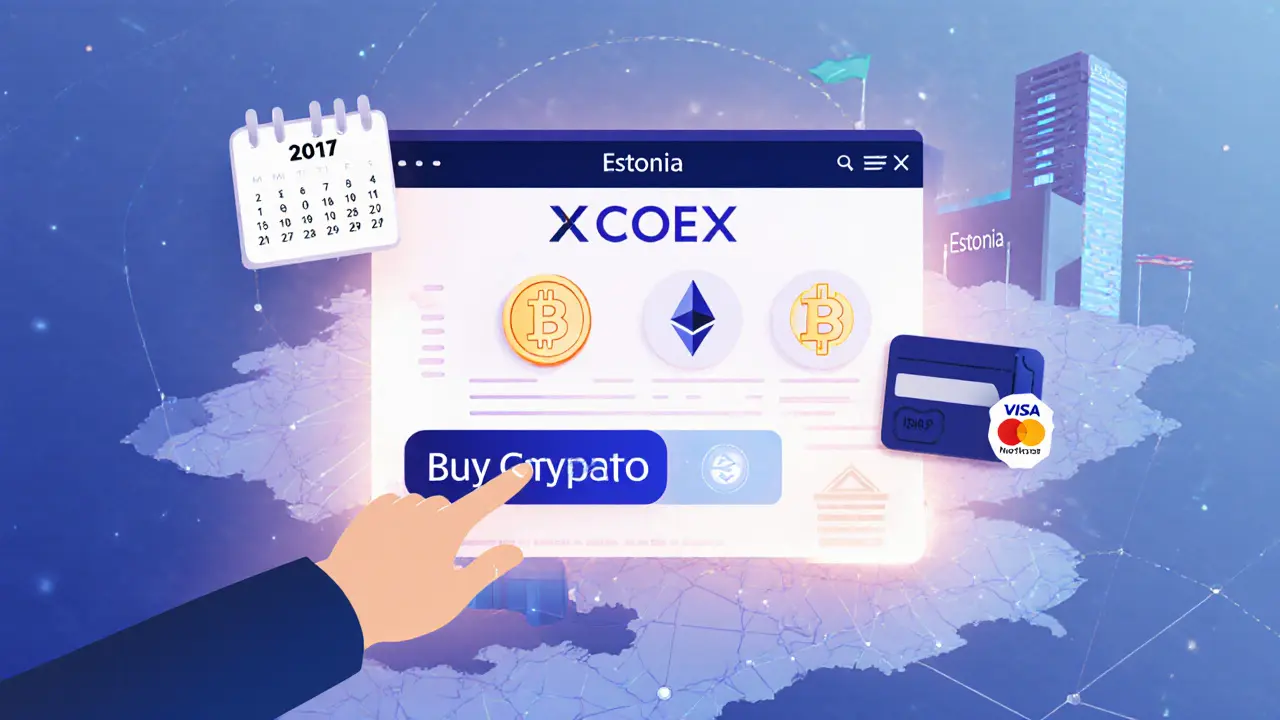
XCOEX Fee Calculator
Estimate your trading fees on XCOEX based on your trade volume and selected cryptocurrency.
Estimated Trading Fees
Fee Structure Overview
XCOEX charges a variable fee structure ranging from 0.25% for small trades to 1.5% for larger volumes. For reference, the fee tiers are:
- Below $1,000: 0.25%
- $1,000–$10,000: 0.25%
- $10,000–$50,000: 0.50%
- Above $50,000: 1.5%
Note: Exact fee tiers depend on trading volume and are subject to change. Contact XCOEX support for precise details.
When you hear the name XCOEX is a centrally managed cryptocurrency exchange that launched in 2017 and is registered in Estonia under the VASP regime, you probably wonder whether it lives up to the hype. Below is a no‑fluff rundown of what the platform actually offers, how its fees stack up, how safe your assets are, and who should (or shouldn’t) consider signing up.
What XCOEX Claims to Be
According to the exchange’s own XCOEX website, the service is an “all‑in‑one” hub that lets you buy, sell, and hold more than 50 crypto assets while using a built‑in wallet. It markets itself as a bridge between traditional finance and digital assets, highlighting direct bank‑card deposits and withdrawals - a feature many larger exchanges still route through third‑party processors.
Registration Process and KYC
Signing up is intentionally simple: provide an email, set a password, verify the email link, then upload a photo ID and proof of address for the KYC check. The verification usually clears within a day, though a few users have reported occasional delays during peak periods. Two‑factor authentication (2FA) is mandatory after the first login; you can choose Google Authenticator or SMS codes.
Asset Coverage
At launch XCOEX supported a handful of major coins. Today the list has grown to over 50, including the heavy‑hitters Bitcoin (BTC), Ethereum (ETH), Litecoin (LTC), Ripple (XRP) and the stablecoin Tether (USDT). The selection is modest compared with giants like Gate.io (3,500+ assets) or KuCoin (700+ pairs), but it keeps the UI uncluttered.
Fee Structure
Trading fees range from 0.25% for the smallest trades up to 1.5% for larger volumes. XCOEX does not publish a detailed tier table, so you need to contact support for exact breakpoints. Deposit fees are zero for most cards, while withdrawal fees vary by currency - for example, a Bitcoin withdrawal costs 0.0005BTC, and an Ethereum withdrawal costs 0.005ETH. Compared with a flat 0.2% maker‑taker model on some rivals, XCOEX feels a bit pricier on high‑volume trades.

Security Measures
Security is a mixed bag. The exchange stores the majority of user funds in cold storage, a standard practice to keep assets offline. Two‑factor authentication adds a second barrier, and the platform supports IP whitelist for extra protection. However, XCOEX has no public security audit from a recognized blockchain firm, and it lacks industry‑grade certifications (e.g., ISO27001). For a small exchange, the self‑reported security measures are adequate for most casual traders, but advanced users may want a platform with third‑party audit reports.
Liquidity and Trading Experience
Liquidity on XCOEX is sufficient for the core assets (BTC, ETH, USDT) but thin on lesser‑known altcoins. Order types are limited to market orders; there are no limit, stop‑limit, or trailing‑stop options. The interface is clean, with a single page showing price, chart, and a “Buy” button. For beginners, that simplicity is a plus, but seasoned traders will miss the depth found on KuCoin or SwissBorg.
Customer Support
Support is handled exclusively via email. Response times average 24‑48hours, and there is no live chat or phone line. Community presence is low - only a handful of Reddit mentions and no listings on Trustpilot or Sitejabber. If you value rapid help, you might find the support model frustrating.
Comparison With Popular Exchanges
| Feature | XCOEX | Gate.io | KuCoin | SwissBorg |
|---|---|---|---|---|
| Founded | 2017 | 2013 | 2017 | 2017 |
| Assets Supported | ~50 | 3,500+ | 700+ | 100+ |
| Min Trading Fee | 0.25% | 0.20% | 0.10% | 0.15% |
| Regulatory Scope | Estonia VASP | Malta / Seychelles | Multiple EU licences | France, Switzerland, Gibraltar |
| Mobile App | No official app | iOS & Android | iOS & Android | iOS & Android |
| Direct Card Deposit | Yes | No (uses processors) | No (uses processors) | Yes |
From the table you can see XCOEX shines in direct card deposits but falls short on asset variety, advanced order types, and mobile accessibility.

Pros and Cons Summary
- Pros: Simple UI, direct card funding, decent fees for low‑volume traders, basic 2FA and cold storage.
- Cons: Limited coin list, no mobile app, thin liquidity on smaller assets, minimal order‑type support, lack of third‑party security audits.
Who Should Consider XCOEX?
If you’re a crypto newcomer who wants a straightforward way to buy Bitcoin or Ethereum with a Visa/Mastercard and you don’t need fancy charting tools, XCOEX fits the bill. It also works well for European users who prefer an Estonian‑registered service with Euro‑friendly deposits.
Conversely, if you trade high volumes, need limit orders, or demand institutional‑level security certificates, you’ll likely feel constrained.
Verdict - Is XCOEX Worth Your Time?
In short, the platform delivers on its promise of simplicity but doesn’t compete on breadth or depth. For a XCOEX review that balances cost, security, and usability, the answer is: use it for small, occasional purchases, but don’t make it your primary exchange if you’re looking to scale up.
Next Steps
- Visit the official XCOEX website and create a free account.
- Complete the email verification and upload your ID for KYC.
- Enable Google Authenticator for two‑factor protection.
- Test a small card deposit (e.g., $50) to gauge processing speed.
- If the experience meets your expectations, consider expanding to larger trades; otherwise, explore alternatives like KuCoin or SwissBorg.
Frequently Asked Questions
Is XCOEX regulated?
XCOEX holds a VASP licence in Estonia, which means it complies with the EU’s anti‑money‑laundering rules but does not have the multi‑jurisdictional licences that larger exchanges boast.
Can I withdraw crypto to an external wallet?
Yes. After passing KYC, you can send assets to any external address. Withdrawal fees apply per currency.
What fiat currencies does XCOEX support?
The platform primarily accepts Euro and US Dollar via bank cards. Direct bank transfers are not offered.
Is there a mobile app for XCOEX?
No official iOS or Android app exists. Users rely on the responsive web interface, which works on most modern browsers.
How does XCOEX’s fee compare to KuCoin?
KuCoin offers a lower base maker‑taker fee of 0.10% for high‑volume traders, while XCOEX starts at 0.25%, making KuCoin cheaper for frequent or large trades.


Comments
Michael Phillips
While XCOEX’s fee schedule looks straightforward on paper, the lack of a publicly posted tier table makes it harder for traders to plan cost‑effective strategies. The 0.25 % floor is decent for occasional small trades, but once you cross the $10k‑$50k range the jump to 0.5 % feels steep compared to rivals. Security-wise, cold storage of the majority of assets is reassuring, though the absence of third‑party audit reports leaves a gap. Overall, it’s a service that aligns with beginners who value simplicity over advanced features.
Mark Bosky
Indeed, the fee transparency could be improved; many users appreciate a detailed ladder rather than a vague “contact support” note. From a compliance perspective, the Estonian VASP licence satisfies EU AML requirements, yet it does not convey the same confidence as a multi‑jurisdictional charter. The mandatory 2FA after the first login is a solid baseline, but offering hardware‑token options would elevate security. Additionally, the interface’s clean design reduces onboarding friction, which is a notable plus for new entrants.
Jason Duke
Wow!! XCOEX really tries to brag about “direct card deposits”!!! But look at those withdrawal fees-yeah, 0.0005 BTC might sound tiny, but it adds up fast!!! And the “no mobile app” claim? In 2025 that’s practically a deal‑breaker!!!
Liam Wells
One must, however, point out the glaring inconsistency in the platform’s marketing versus its operational realities; while the promotional material emphasizes instant card funding, the actual processing times often exceed the advertised windows, leading to user frustration. Moreover, the claim of “cold storage” is unverified without an independent audit, rendering the security narrative somewhat hollow. The absence of limit or stop‑order functionality further diminishes the exchange’s appeal to serious traders. In short, the platform appears to be a re‑packaged retail solution rather than a robust trading venue.
Franceska Willis
Yo, I dived into XCOEX last week and let me tell ya-it’s kinda like a tiny boutique shop next to a massive mall; you get what you need but not the fancy stuff. The UI is super clean, no clutter, which i love, but i wish they had more altcoins, cause the list feels a bit thin. Also, the support emails sometimes take ages, i’ve seen replies after 36 hrs, which is kinda annoying. Anyway, for a quick buy of BTC or ETH it does the job, just don’t expect pro‑level tools.
Don Price
The security architecture of XCOEX, as described in its public documentation, suggests a hybrid model wherein the majority of user funds are held offline in cold storage, yet a non‑trivial portion remains in hot wallets to facilitate immediate withdrawals, and this bifurcation, while common among exchanges, introduces an attack surface that is seldom quantified in the platform’s disclosures; consequently, users are left to infer the adequacy of the cold‑storage procedures without the benefit of a third‑party audit, which, in an industry where audit transparency has become a differentiator, represents a significant omission that could affect risk‑averse participants; furthermore, the mandatory implementation of two‑factor authentication (2FA) after the initial login, albeit commendable, stops short of offering hardware token support, a feature that many security‑conscious traders now consider a baseline requirement; on the fee side, the tiered structure, starting at 0.25 % for sub‑$1,000 volumes and escalating to 1.5 % for larger trades, appears competitive for low‑volume users but quickly becomes disadvantageous for high‑frequency participants when juxtaposed with the sub‑0.2 % maker‑taker rates prevalent on platforms like KuCoin or Binance, thereby potentially eroding profit margins for professional arbitrageurs; liquidity, while satisfactory for heavyweight assets such as Bitcoin and Ethereum, exhibits pronounced thinness for lesser‑known altcoins, resulting in slippage that can materially impact execution quality; the platform’s order‑type offerings are confined to market orders, precluding the use of limit, stop‑limit, or trailing‑stop mechanisms that are essential for nuanced risk management; this limitation, coupled with the absence of a native mobile application, suggests a product focus oriented toward casual or entry‑level users rather than seasoned traders; customer support, limited to email correspondence with typical response windows of 24–48 hours, may be insufficient for time‑sensitive issues such as withdrawal delays, and the lack of live chat further underscores a minimalist service model; finally, regulatory oversight, while present through the Estonian VASP licence, does not equate to the multi‑jurisdictional licensing frameworks adopted by larger exchanges, potentially exposing users to regulatory uncertainties in cross‑border scenarios; in totality, XCOEX delivers a functional, albeit basic, trading experience that satisfies newcomers seeking simplicity while falling short of the comprehensive features and assurances demanded by the more advanced segment of the crypto community.
Jasmine Kate
Honestly, XCOEX feels like a toddler's sandbox compared to real exchanges!
Mark Fewster
That analogy hits the mark; the platform’s simplicity can be charming, yet it also means you miss out on essential tools for sophisticated trading. The lack of advanced order types is a real limitation for anyone looking to fine‑tune entries and exits. Patience with support is required, given the email‑only model.
Dawn van der Helm
Love the simplicity-perfect for a first‑time buyer 😊
EDWARD SAKTI PUTRA
I understand the appeal of a clean interface, especially when just starting out. Enabling two‑factor authentication right away adds an extra layer of safety that many beginners overlook.
Jack Stiles
Gotta say, the site is pretty easy to navigate, but i wish they had a proper mobile app-i’m always on my phone.
Nicholas Kulick
The fee tier explanation could be clearer on the site.
Heather Zappella
XCOEX’s regulatory status as an Estonian VASP provides a baseline of compliance with EU anti‑money‑laundering directives, which is reassuring for users concerned about legal oversight. However, the platform’s limited asset selection and the absence of a publicly audited security report may deter more experienced traders seeking broader exposure. The fee structure, while transparent for low‑volume users, becomes less competitive for high‑frequency activity compared to exchanges that offer tiered maker‑taker discounts. Overall, the exchange serves a niche of newcomers and occasional traders who prioritize ease of use over advanced functionality.
Bryan Alexander
Absolutely! For anyone just dipping their toes into crypto, XCOEX offers a friendly gateway-no overwhelming charts, just a straightforward buy button. 🌟 It’s the kind of platform that can boost confidence and get you comfortable with the basics. Keep in mind, as you grow, you’ll eventually need a more feature‑rich environment, but for now, it’s a solid start! 🚀
Patrick Gullion
I get why some dismiss XCOEX as “basic,” but sometimes simplicity is exactly what the market needs, especially for newcomers who get lost in the sea of options on larger exchanges. The direct card deposit feature cuts through the usual hassle of third‑party processors, which can be a lifesaver for quick trades. Still, if you’re looking for deep liquidity and advanced order types, you’ll have to look elsewhere.
Ken Pritchard
That’s a fair point; striking a balance between user‑friendliness and professional tools is tricky. New users benefit from a low‑barrier entry, while seasoned traders crave depth. Perhaps XCOEX could consider a tiered interface that unlocks advanced features as users become more comfortable.
Caitlin Eliason
We must not forget that promoting an exchange without full security audits sends a dangerous message to the community; it normalizes complacency in an industry already plagued by hacks. Users deserve transparency, and platforms have a moral duty to provide it. Let’s hold them accountable and push for higher standards. 🛡️
Michael Phillips
Transparency is indeed the cornerstone of trust in crypto services. When exchanges openly share audit results, they empower users to make informed decisions.